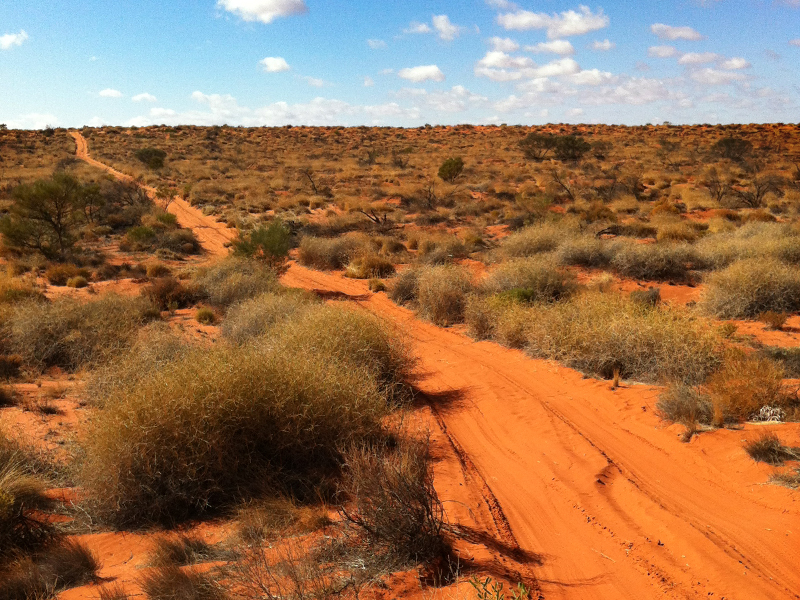What is off road driving?
Generally, it means driving on sand and gravel unsealed roads or tracks. Driving totally off road (that is, where there is no track at all) has the potential to create damage to the environment and we really don’t recommend it unless, for some reason, you have to do it.
Many of the roads or tracks that we talk about in the Travel Outback Australia are unsealed. Some of the tracks are sand and so between them you need to adopt different driving techniques to ensure that you will get to where you want to go.

One of the biggest things to remember is safety: both your own and that of others. If you are going to travel outback Australia then you need to consider some of the things that we mention below.
Driving off road is different to driving on a predictable sealed surface. The first rules are to slow down and ‘read’ the surface – in other words, keep your eyes on the track or road ahead. Many people have had accidents in the outback because they were simply driving too fast and had little or no experience with driving on unsealed roads.
Okay, so let’s talk about driving on sand. Believe it not there are different types of sand. It can change, too, depending on whether it is hot or cold outside. If it’s cold it is usually much easier to drive on but if hot, it can cause you to become bogged much more easily. This is due to viscous nature of sand, the colder the sand is the more dense it is and the warmer it is the less dense it is so you sink into it much more quickly.

Flat, sandy ground normally won’t give you too much trouble, but if you come up against a dune crest or sandhill, then this is the time most people get into trouble. Don’t drive on sand if you only have a two wheel drive vehicle, you are only asking for trouble. I’d need more than two hands to count the number of people I have pulled out of sand that have been driving a normal car where they shouldn’t have been.
If you are in a four wheel drive vehicle make sure you engage 4WD before you get bogged; this will be a button on the dash or a lever next to the one you usually use for changing gears. The other important thing to remember is to engage the front freewheeling hubs if the vehicle has them, before engaging the 4WD lever (it should be shown in your vehicle manual if it has one). Not all four wheel drives have them but it is better to check before the vehicle digs in and you get stuck.
On that note, remember this: if you find yourself about to get stuck, no matter what the surface, don’t simply put your foot down. This can make any situation far worse because all of a sudden the car digs in and makes it that much harder to get out or if wet then you’ll likely skid off the track into the nearest gutter or verge. Get out and investigate what is causing the problem.

If you do get stuck get out of the car and think about what you are going to do. Plan to get stuck before you leave and take the right equipment like a shovel, compressor, Maxtrax or exhaust jack. Some people like hi-lift jacks but you must be careful with these as they can not only injure but cause damage to your car if used incorrectly.
In sand one of the best things you can do to make progress easier is to let the tyres down to about 20 psi. This increases the ability to gain traction by spreading the weight of the vehicle over a larger area. Remember though once you get back onto a hard surface then you need to re-inflate the tyres back to normal pressure with that air compressor you are carrying.
Don’t panic, and if you can’t get unstuck, then think about your next move. Remember your safety is your responsibility. Tell someone where you are going and when you will return. That way they will raise the alarm if you can’t. The most important thing to do is to stay with your car and wait for help to arrive. If you have followed a few of these simple procedures then you will be fine.
On unsealed roads our main advice is to drive to the condition of the road. Outback Australia has a huge network of roads and tracks that are not maintained regularly. For this reason you never know what is around the next bend or what damage may have been caused by a passing storm.
Slow down, don’t rush and you’ll enjoy the scenery that much more. Some of our best destinations have stunning scenery to be seen along the journey, so good that it sometimes matches getting to wherever you’re going. So don’t wait to get out there, plan, do and relive those experiences for years to come.
Have you got any top tips for off road driving to share?
Agreed, you should be totally prepared before going off-road as it is not the guarantee that you will only face favorable conditions as it is not the highway you are driving at.